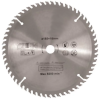The Makita XGT 40V Reciprocating saw (GRJ01Z) is an upgrade on the older 36V LXT Model. This review is going to look at what has changed and determine if the 40V XGT version actually delivers more power.
Visually, there isn’t much to distinguish the Makita GRJ01Z 40V XGT reciprocating saw from the 36V LXT model (XRJ06Z). There are some subtle, yet quite valuable changes that have been made to the basic saw design. This will all be discussed, in detail, when I get onto the full review of the Makita GRJ01Z.
The most obvious difference is the new XGT 40V battery platform. The older model used 2 X 18V LXT batteries to deliver 36V. The new XGT reciprocating saw uses a single 40V battery. I’m sure most of you are asking: What difference can 4-volts make? Not much, granted. However, the XGT batteries are more advanced than LXT. Essentially, the XGT batteries are capable of delivering more amps than the older batteries. This is achieved by using upgraded lithium-ion cells. DeWalt, Milwaukee, and Bosch have done pretty much the same thing with their high-output batteries – all using various trademarks to distinguish these from their regular Li-ion batteries.
With a higher output battery, it’s possible to use a higher watt motor. This results in more power. According to Makita, the 40V XGT reciprocating saw will cut through lumber 35% faster than the old 36V LXT model. When cutting metal, it’s about 10% faster.
When all is said and done, the Makita GRJ01Z 40V XGT reciprocating saw is a more powerful machine. The battery setup is also more convenient and a little more compact. Using a single 40V battery works better than 2 X 18V batteries.
To find out what else has changed between the Makita XGT vs LXT reciprocating saws, keep reading.
Makita GRJ01Z ǀ Comprehensive Review
Features:
- Brushless motor delivers up to 35% faster cutting speed
- Digital communication within XGT® optimizes performance
- Metal reinforced gear shaft and self-lubricating slider for increased durability
- Variable 2-speed brushless motor delivers 0-2,300 (Low) and 0-3,000 (High) strokes per minute
- Long 1¼” stroke length provides increased cutting efficiency
- Refined crank mechanism design minimizes blade deflection and reduces vibration
- Weighs only 9.9 lbs. for reduced operator fatigue
- Large two-finger variable speed trigger for operator convenience
- Electric brake for maximum productivity
- “Tool-less” blade change lever for faster installation and removal; shoe adjustment for blade longevity
- Built-in L.E.D light with pre glow and afterglow illuminates the work area
- Retractable tool hook secures the tool when not in use
- XPT™ is engineered to provide increased dust and water resistance in harsh job site conditions
- The digital communication within XGT® actively monitors and protects against overload, over-discharge and overheating
- XGT® Tools and Batteries are designed with a multi-layer contact interface for more constant power delivery to take on high-current demands
- XGT® Batteries feature rigid rails with impact-resistant construction to secure the battery to the tool during high-demand applications
- The XGT® Rapid Charger with dual-fan design circulates air through the battery to cool the battery and circuit board quickly for faster charging
- The XGT® Rapid Charger’s digital display indicates battery charge level (-80%, +80%, 100%)
- Makita 3-year warranty
Review:
I’ve always loved the solid reliability that makes Makita tools so great. Plenty of aluminum, both inside and out, really gives you a sense that you’re holding a machine that can endure just about anything. Makita tools, in general, hold up to treacherous working environments without showing any signs of distress.
Makita Extreme Protection Technology (XPT) is a hallmark for the brand and works incredibly well. By super-insulating the tool from dust and moisture, they last much longer and remain thoroughly reliable.
I’m happy to report that all this durable engineering is incorporated into the design of the Makita GRJ01Z 40V XGT reciprocating saw.

When comparing this model to the 36V LXT version, many of the great features that we all respect have remained. It has the same rubber exterior that does a lot to eliminate vibrations. There have been some minor refinements as to how this rubber cladding is applied, making it a bit more durable. The practical hanging hook is still the same.
The large trigger switch is also the same, as is the slide switch for the two-speed settings. Blade speed remains unchanged at 0 – 2,300 SPM (low) or 0 – 3,000 SPM (high). It utilizes the same blade with a 1¼” stroke. This gives you a cutting capacity of 10” for wood, using a 12” blade, or 5¹⁄₈” when cutting pipe.
Because the new 40V XGT battery has improved power capabilities motor wattage is increased, improving torque and power. This makes the new 40V XGT reciprocating saw up to 35% faster than the 36V LXT model when cutting through wood.
The Makita GRJ01Z is a little heavier than the XRJ06Z when comparing bare tool weight. However, the 40V XGT battery is lighter compared to the 2 X 18V LXT set up with the same AH. As a result, the nest weight (tool and battery) is slightly lower when comparing the XGT saw to the LXT. The Makita GRJ01Z weighs 9.9 LBS with the battery vs 10.2 LBS for the LXT model. Not much of a difference really. The best thing about using the 40V XGT battery is the compact design. It is less chunky than using 2 X 18V LXT batteries. The new model has a vibration mitigation design for the battery. I think this should improve battery contact, thereby increasing battery efficiency and long-term durability.
I really like the small design improvements that have been implemented on the 40V XGT reciprocating saw. Anyone who has used the Makita 36V LXT reciprocating saw can attest to the irritating movement on the adjustable shoe. The Makita engineers have improved the tool-free shoe adjustment to make it much sturdier. The nasty vibration at the shoe has been greatly reduced.
The blade insertion mechanism has also been refined. The blade mechanism is now enclosed in the base of the tool housing. It is no longer exposed. This makes it safer and more durable. It’s now much easier to insert the blade without removing the shoe. The Release lever has been repositioned on the tool body, not at the actual blade mechanism. This new system, which secures the blade much more tightly, has a slight downside. It now takes a lot more force to push the blade into the slot. If you’re not wearing gloves, you may end up cutting yourself because of the amount of force you need to exert on the blade.
The Makita XGT 40V reciprocating saw has a brighter LED light which is now positioned in front of the blade. This makes it much better for working in dark and dingy spaces.
I’ve heard mixed verdicts from people who have compared the Makita 40V XGT reciprocating saw vs the 36V LXT model. Some say it’s not worth the extra investment. Others love the new model, saying it’s definitely worth it.
There’s a definite improvement in power, especially if you’re cutting wood. Personally, I feel that the improvements made to the shoe and blade tool-free adjustment mechanisms are fantastic. Although, I’m not sure I’d replace a perfectly fine 36V LXT saw for a new XGT one simply for these advantages.
If I were buying a new reciprocating saw, I think it would be an easy decision. Pay the extra cash and get the 40V XGT reciprocating saw. The advantages are worth it and the 40V XGT battery platform is the way forward. There are now over 50 tools in the XGT lineup. Okay, this is a far cry from the over 200 tools available in the 18V LXT range, but the XGT series is growing steadily. In a few years from now, I’m pretty sure the 40V XGT platform will dominate. You may as well start changing to the 40V platform.









